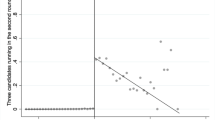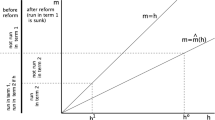Abstract
The present paper uses various data sets and statistical techniques to examine the outcome of gerrymandering under the Voting Rights Act of 1982 on turnover rates in the U.S. House of Representatives, as well as the competitiveness in Party primaries for House seats. Evidence presented here suggests that political redistricting at the federal level (namely for U.S. House seats) has tended to favor incumbents in both the Party primaries and general elections. In fact, some results suggest that turnover rates (for 1988) are between 8.9 and 10.3 percentage points lower within states that engaged in such redistricting efforts. Our findings generally support the main tenets of the public choice view of legislator behavior.
Similar content being viewed by others
Author information
Authors and Affiliations
Rights and permissions
About this article
Cite this article
Mixon, F.G., Upadhyaya, K.P. Gerrymandering and the Voting Rights Act of 1982: A public choice analysis of turnover in the U.S. House of Representatives. Public Choice 93, 357–371 (1997). https://doi.org/10.1023/A:1017982929415
Issue Date:
DOI: https://doi.org/10.1023/A:1017982929415




